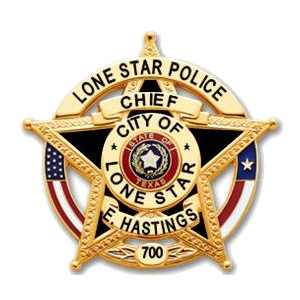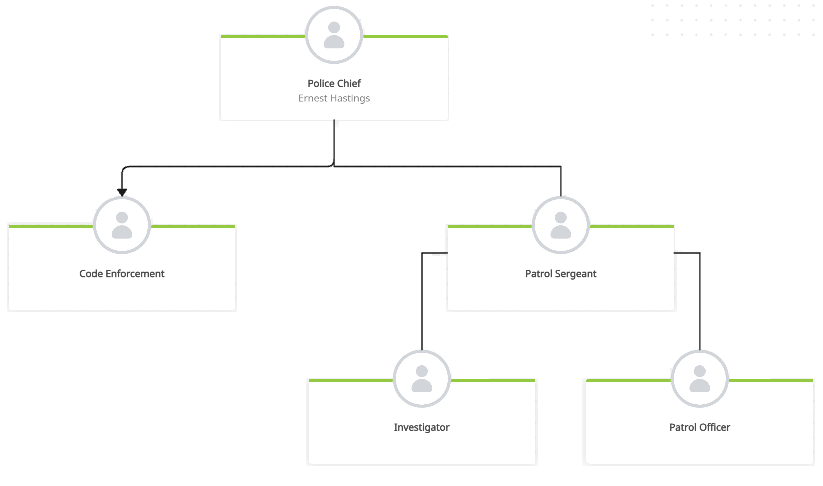 |
| LONE STAR POLICE DEPARTMENT |
| Policy 1.2 Jurisdiction, Organization, and Authority |
| Effective Date: 25-SEP-2024 |
| _______________________________________________________ Ernest Hastings, Chief of Police |
I. POLICY
The department is established by state law and local ordinance, and consists of a Chief of Police and other full and part-time officers and non-sworn employees as determined by the city manager and council. The Chief executive of the police department is the Chief of Police, appointed by and subordinate to the city manager. The Chief, in turn, appoints police officers who are charged with enforcing the laws of the State of Texas and all local ordinances. The jurisdiction of the police department is limited to the city limits, except in cases of pursuit of offenders who have committed a violation within the city limits and then flee outside the city limits, or when another department requests assistance, or when enforcing laws on property owned by the city but outside its boundaries. The organization of the police department shall support the effective and efficient accomplishment of departmental responsibilities and functions according to community-oriented policing principles.
II. PURPOSE
The purpose of this policy is to describe the jurisdiction and organization of the police department, outline its rank structure, and assign responsibilities, functions, and duties.
III. AUTHORITY AND AGENCY JURISDICTION
The jurisdiction of the Lone Star Police Department is limited to inside the city limits of the city with certain exceptions.
- Police officers appointed by the city have all the authority granted to them by the State of Texas as Peace Officers. Appointed officers have the responsibility to act within the law, preserve order, arrest offenders, and protect the residents and visitors to our city.
- Officers have arrest authority anywhere within the State of Texas; however, the exercise of that authority will be limited when outside the city limits to those situations involving a felony or the use of violence or threatened use of violence against a person, and then only to the extent that the officer is able to safely intervene. When off-duty or out of our primary jurisdiction, officers seldom have appropriate equipment, communications, or the assistance needed to properly intervene in dangerous situations. Intervention in these cases may be resolved by calling appropriate authorities and remaining on scene to provide witness information. (An official map of the city limits will be maintained at the department.)
- Officers have authority to enforce the law on property owned by the city but outside the city limits.
- Officers have authority to pursue offenders outside the city limits who have committed violations inside the city pursuant to the department's pursuit policy. When investigating a crime that occurred inside the city, officers may utilize their authority to conduct investigations, including interviewing witnesses, interrogating suspects, executing search and arrest warrants, and making lawful arrests without warrants anywhere in the State of Texas.
- Officers have authority to enforce the law in another jurisdiction pursuant to a properly executed mutual aid agreement.
- While officers have full authority to make arrests, issue summonses, and use force in enforcing the law, officers are also expected to use discretion and common sense in the application of this authority. Officers should always seek the least intrusive level of intervention appropriate to preserve the peace and protect the public safety.
IV. ORGANIZATIONAL STRUCTURE, CHAIN OF COMMAND, AND AUTHORITY
- Organizational structure
- The city charter (properly describe document) authorizes the creation of a police department to be headed by a Chief of Police. The Chief of Police is responsible for directing all activities of the department. This direction is accomplished through written and oral orders as well as by personal leadership. Written orders take the form of general orders, standard operating procedures, and other directives as needed.
- The department consists of a police Chief, two sergeants, and as many police officers as the town council determines are required to protect and serve the community and otherwise support or carry out the department's objectives.
- Chain of Command and Succession
- The police Chief has full control over departmental activities. In the absence of the police Chief, the sergeant shall take command and notify the Chief of all major decisions that he or she may make. If the Chief and the sergeant are not available, then the senior patrol officer shall take command until a ranking officer is available, and shall make any necessary reports to the Chief.
- Plans for any event utilizing departmental personnel will clearly delineate the command structure and outline the span of control.
- Authority and responsibility
- At each rank within the department, personnel are given the authority to make necessary decisions for the effective performance of their responsibilities. The department is committed to fostering an organizational climate that rewards employees for initiative, innovation, community involvement, and problem solving.
- Each employee shall be held accountable for the use of, or failure to use, delegated authority. Any employee with questions concerning his or her delegated authority shall refer the matter to the on-duty supervisor or the Chief of Police for prompt resolution.
- Supervisors will be held accountable for the condition and preparedness of the personnel assigned to them.
- Supervisors are responsible for the good order and sanitary condition of department offices, vehicles, and equipment.
- Supervisors are responsible for the efficiency, discipline, and morale of employees under their charge. Supervisors shall investigate or cause to be investigated all allegations of employee misconduct.
- Supervisors shall ensure that employees have been supplied with all appropriate written orders and shall instruct them thoroughly on all oral and written orders. Supervisors shall regularly review and instruct subordinates in pertinent laws, ordinances, and necessary skills.
- Authority of the Chief of the Department
- As the Chief executive of the department, the Chief of Police has full authority and responsibility for the management, direction, and control of the operation and administration of the department.
- The Chief of Police shall attend the initial police training provided by the Law Enforcement Management Institute of Texas as required by the Texas Education Code within 12 months of appointment.
- The Chief of Police is also the Departmental Homeland Security coordinator and will maintain relationships with the State Homeland Security office and other state and federal Homeland Security resources.
- ORGANIZATIONAL CHART
- The attached chart denotes chain of command and intra-department relationships.

- The organizational chart is reviewed annually and updated as necessary to illustrate the current functioning of the department.
- The attached chart denotes chain of command and intra-department relationships.
- OATH OF OFFICE REQUIRED
- All sworn officers will swear or affirm any oath required by state law or city ordinance before assuming law enforcement duties. All sworn officers shall abide by the Law Enforcement Officer's Code of Ethics. A copy of the law enforcement Code of Ethics is provided to each sworn officer.
- Such oath shall be made in public and shall be witnessed by the city secretary or other notary who shall witness and record it on the form approved by the department. The oath shall be filed in the officer’s personnel file.
- AUTHORITY TO CARRY WEAPONS AND USE FORCE
- Sworn officers who are licensed peace officers of the State of Texas are authorized to carry firearms and other weapons as identified in these directives, and to use force when necessary and to the extent authorized by these orders and state law in enforcing the law and protecting the public.
- Sworn officers who are off-duty are encouraged to carry firearms in order to take action when necessary to preserve life and property.
- Sworn officers who are off-duty shall not consume alcohol "to the extent in which it causes impairment" if they're carrying a firearm.
- OFF-DUTY AUTHORITY
- Liability Protection: Officers of this agency have liability protection for the on and off-duty performance of official duties. This protection does not extend to those actions that the police officer knew, or reasonably should have known, were in conflict with the law or the established policies of this department.
- Off-Duty Responsibilities: While off duty, the police officer is responsible for immediately reporting any suspected or observed criminal activities to on-duty authorities. When an officer is prohibited from taking off-duty enforcement actions under provisions of this policy, the officer shall act as a trained observer and witness to the offense, and shall summon on-duty personnel as soon as reasonably possible. Where an arrest is necessary, the off-duty arresting officer shall abide by all departmental policies and procedures.
- Prohibitions of Off-Duty Arrests: Despite the fact that a police officer has police powers and responsibilities 24 hours a day throughout the jurisdiction, the off-duty officer generally should not attempt to make arrests or engage in other enforcement actions when any of the following circumstances exist:
- The officer is personally involved in the incident underlying the arrest.
- The officer is engaged in off-duty employment of a non-police nature.
- The officer's ability or judgment to use a firearm or take a person into custody has been impaired by use of alcohol, prescription drugs, or other medication, or by a physical ailment or injury.
- A uniformed police officer is readily available to deal with the incident.
- Off-duty officers in plain clothes shall follow all orders issued by uniformed officers without question or hesitation during enforcement encounters and shall identify themselves as law enforcement officers as prescribed by departmental training. The department’s training authority shall establish protocols (including the use of signs and signals) for recognition of off-duty officers in plain clothes so as to reduce the potential of misidentification of such personnel during enforcement encounters. Such protocols shall be reviewed periodically during in-service training.
- RESERVE OFFICERS
- Reserve officers are authorized by the City Charter. Reserve officers have the same authority and responsibility as regular sworn officers when on-duty and working for the department. They are bound by the same policies and standard operating procedures as regular officers.
- Reserve officers are required to have the same level of both initial and in-service training as regular officers.
Previous page: Department Policies